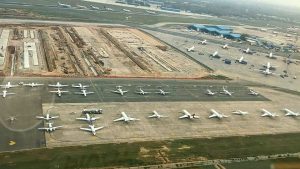By Pulak Sen
- Storage and return to service of grounded aircraft

New Delhi. 12 April 2020. The pandemic COVID-19 engulfing the globe today has caused tremendous loss not only to the mankind, but also to the world economy. I deal with a sector, aviation, which has been a global denominator to ascertain the growth and stability of a nation. India is badly hit by this deadly pandemic which is causing humongous losses to the aviation industry with this lockdown. Before this tragedy the country had gained the Third position in the Global Aviation scenario.
With the announcement of a total lockdown, the domestic and international skies have also been shut for India’s airlines. As a result, India has 650 commercial aircraft parked across 22 airports which will only fly once the Government lifts the restrictions. Little known to most, storing aircraft in itself, is a complex process. This is a challenge India’s airlines are facing now and will face continuously in the weeks ahead.
One must realise that India is a vast country with varied weather conditions. There are airports in the dessert region of Rajasthan, which are usually sandy, down south the weather is humid and so on. Hence the preservation and restoration process of an aircraft can defer from region to region.
Considerations before storing aircraft
Thorough planning before storing an aircraft helps in a smooth return to service. Critical to this process is ensuring geographic locations are pre-assigned, risk assessments are carried out and support equipment and personnel are lined up. Of 650 aircraft in the commercial airlines fleet of India that are currently parked, 78 per cent are narrow body jets (mainly the Airbus 320 and Boeing 737s) with the balance split between 8 per cent widebodies and 14 per cent regional aircraft. Majority of these aircraft, more than 80 per cent, are on lease compared with the global average of 41 per cent. This effectively means that even while only parking aircraft, there is a cash-outflow in terms of lease rentals each month. The world’s top lessors have leased aircraft to airlines in India.
| Names of Lessors | Number of Aircraft |
| Avolon | 62 |
| Aircastle | 30 |
| BOC Aviation | 24 |
| BBAM | 29 |
| DAE Capital | 29 |
| Goshawk Aviation | 28 |
| CDB Aviation | 26 |
| ALAFCO | 20 |
| ICBC | 24 |
| AMCK Aviation | 18 |
Duties of a Lessee
The lessee i.e. the airline, is responsible for the maintenance and storage, if required, of the aircraft until the termination of the lease. The aircraft must be maintained in accordance with the manufacturer’s maintenance programme, the rules and regulations of the aviation authority, the manufacturers type design and in accordance with any other regulations or requirements necessary in order to maintain a valid certificate of airworthiness for the aircraft at all times.
Throughout the lease term, the lessee bears the entire risk of loss, theft, damage and destruction of the aircraft. To cover this risk and various others, insurance requirements are mandated by the lessor, the lessee maintains various insurance covers. Airlines must do their due diligence before parking aircraft as there could be serious repercussions for not following procedure.
Several have raised the question that do airlines not plan for such calamities given the experience with 9/11, SARS, the global financial crisis of 2008. The answer is that some do, while others do not. One can well say with complete certainty that in the current case, airlines have had to rush to park aircraft as a scenario like the one posed by COVID-19 was simply outside the realm of imagination, much less planning was possible. Even so, the next few days will be critical in ensuring that the aircraft parked have everything in order and airline personnel dot the I’s and cross the T’s.
Procedure for storing aircraft
The procedure to store aircraft is usually outlined in the aircraft manuals and also the maintenance programmes. Additionally, regulators have a set of criteria that must be adhered to.
Parking an aircraft is covered extensively with a section dedicated to Parking, Storage and Return to Service. The document further highlights procedures of short-term and long-term storage and the timelines are defined. For instance, for the Boeing 737, a time period of 60 days is considered as a marker. Any aircraft that is being stored for a time period that exceeds 60 days comes under the long-term storage guidelines. This marker may be critical in helping one forecast how soon the restrictions will be lifted.
Before the aircraft is put into storage, fuel and oil-levels are recorded and adjusted as required. The key risk that has to be guarded against is contamination of fuel in the wing tanks and ensuring adequate oil levels to guard against parts drying out. Some companies also add an element to fuel tanks called Biobor to keep microbial growth in the tanks at bay.
As far as the airframe is concerned, visual inspections are carried out with all possible inlets being carefully covered. Depending on weather conditions, landing gear and windows may have to be covered. Hydraulics, flaps, slats and APU may have to be periodically tested to ensure that the lubrication is adequate. Avionics may also be powered on to ensure these are in working condition.
Overall, it is a fairly extensive process, with each check requiring detailed documentation and creation of a long paper trail. Most importantly, Lessor’s must be informed in writing about all scheduled or unscheduled maintenance work and storage of aircraft. There are very specific clauses in an aircraft lease agreement which cover maintenance of aircraft and airlines must comply with these at all times.
Engines are especially critical
Engines often comprise of 40 per cent of the total value of an aircraft. In addition to the aircraft storage, engine storage has its own set of requirements. Lessor’s permit airlines to enter into engine maintenance cost per flight hour, power by the hour (PBTH), fleet management programmes (FMPs) or similar agreements with engine manufacturers or any other engine maintenance facility, provided the terms of such agreement are fully in compliance with the requirements in the lease agreement. This often helps airlines significantly reduce maintenance costs without compromising on the quality of work.
Engineers who are duly trained and certified by the relevant authorities among other things, have to ensure that the engine parts and bearings are properly lubricated, all inlets covered and sealed. Interestingly, each aircraft comes with a set of engine covers and thus one sees aircraft parked with engines covered.
Aircraft engines also need to be run at regular intervals. As an example, when the Boeing 737Max issue surfaced and aircraft were grounded, maintenance programmes required that engineers power up the engines once a week so vaporize any moisture in the oil and fuel systems.
For the current grounding, this however, poses a unique complication – in addition to the fleet being grounded there is a complete lockdown, i.e. personnel movement is restricted. Thus, for the 650 aircraft parked it means that 1300 engines with 14 variants across 5 manufacturers will have to be powered on and run at idle for a specific amount of time (depending on manufacturer recommendations). Indeed, over the next few weeks, airlines and MROs will likely request access for personnel as the engines will be run on the ground as a part of the regular maintenance process. Ironically, this time the access requests may be ones to get to the airport given the lockdown across the country. But it should be manageable given that cargo operations are continuing across airports.
| Engine series in service in India | Number of Engines |
| AE300 | 24 |
| CF34 | 8 |
| CFM56-5B | 196 |
| CFM56-7B | 192 |
| CFM56-LEAP | 82 |
| GE90 | 32 |
| GEnx | 52 |
| PT6A | 10 |
| PW1100G | 272 |
| PW12 | 94 |
| PW15 | 64 |
| PW4000-94 | 6 |
| RB211 | 12 |
| V2500 | 256 |
The Cabin and interiors
Inside the aircraft, certain systems must be deactivated. All windows and doors are ideally covered, as are the landing gear and tires. This is towards protecting them from external elements.
All the galley carts are emptied out, if required seats are covered with plastic sheets and in certain cases some equipment is removed from the aircraft.
The inside cabin is also aired to ensure minimal moisture and also mitigate any impact of heat with Indian Summer setting in.
All of this is also critical towards ensuring that the aircraft, once ready to fly, can be put back to use in the fastest possible time.
Return to service
Once the Government gives the go-ahead for a return to service, airlines cannot simply take the aircraft and return it to service. Extensive documentation and checks are again carried out. The primary goal of aviation is safety and ensuring continued airworthiness. This also poses a regulatory challenge since a regulator is simply not staffed to oversee such a large volume of aircraft. How the return to service will be managed, remains a matter of much debate within aviation circles.
Early return to Lessor
It is fairly evident that the demand for air travel is going to remain subdued for a considerable period of time because of the COVID-19 pandemic. Indian airlines will, in all likelihood, consider an early return of aircraft back to lessors to both reduce cash outgo in the form of lease rentals and reduce capacity. This involves an early termination option (ETO) yet these come with clauses attached.
It must be borne in mind that aircraft Lessors will be extremely reluctant to easily accept an early return of an aircraft without very heavy financial penalties for the airlines. Repricing, renegotiation and revision of terms is contingent on negotiation and without the ability to meet in person this challenge is compounded. It must be remembered that aircraft Lessors too have obligations to their own creditors and an aircraft returned before the end of a lease term, means lost revenue, which no Lessor will let go off without seeking compensation from the airline. Nonetheless, returning an aircraft back to a lessor is an extremely complex and detailed process. Airlines have to comply with stringent redelivery conditions stipulated in lease agreements. The aircraft must be in the same condition as it was when it was given on lease to the airline. Apart from that the aircraft must be airworthy, conform to type design and be in a condition for safe operation, with all aircraft equipment, components and systems, operating within limits approved by the manufacturer and the aviation authority. All repair, maintenance and modifications made to the aircraft, including during storage, must be documented and carried out as per procedures set by the manufacturer. This makes it even more pertinent for airlines to follow due procedure while these aircraft are grounded, as there are hefty penalties involved should they not.
|
Aircraft Type Airline |
Airbus A320* |
ATR 42/72 |
Boeing 737 |
Boeing 747 |
Boeing 777 |
Boeing 787 |
Bombardier CRJ |
Bombardier Q400 |
Embraer ERJ | Total |
| AirAsia India | 30 | – | – | – | – | – | – | – | – | 30 |
| Air-India | 77 | – | – | 2^ | 16** | 27 | – | – | – | 122 |
| Alliance Air | – | 19 | – | – | – | – | – | – | – | 19 |
| Air-India Express | – | – | 25 | – | – | – | – | – | – | 25 |
| Go Air | 57 | – | – | – | – | – | – | – | – | 57 |
| IndiGo | 236 | 25 | – | – | – | – | – | – | – | 261 |
| SpiceJet | – | – | 82^^ | – | – | – | – | 32 | – | 114 |
| Star Air | – | – | – | – | – | – | – | – | 3 | 3 |
| TruJet | – | 6 | – | – | – | – | – | – | – | 6 |
| Vistara | 33 | – | 7 | – | – | 1 | – | – | – | 41 |
| Zoom Air | – | – | – | – | – | – | 4¹ | – | – | 4 |
| Aircraft Type |
Airbus A320 |
ATR 42/72 |
Boeing 737 |
Boeing 747 |
Boeing 777 |
Boeing 787 |
Bombardier CRJ |
Bombardier Q400 |
Embraer ERJ | Total |
| Aircraft Total | 433 | 50 | 114 | 2 | 16 | 28 | 4 | 32 | 3 | 682 |
¹ Zoom Air actual fleet size unknown
^ Actively used on AI pax routes
^^ Includes 13 grounded Boeing 737 MAX 8 aircraft and one damaged aircraft (DGCA has banned the operation of B737 MAX series aircraft in India till further notice)
* Incl. Airbus A319, A320 and A321 series aircraft
** Excludes two aircraft refurbished for VVIP flights
General note: Aircraft data includes aircraft grounded for technical/operational reasons.
Indian Scheduled (and Non-scheduled jet operators) Air Operators – Fleet Data Quick Reference
| Freighter Aircraft |
Boeing 737F |
Boeing 757F | Total |
| Blue Dart Aviation Ltd. | – | 6 | 6 |
| SpiceXpress | 5 | – | 4 |
| Freighter Aircraft Total | 5 | 6 | 10 |
Modified March 26, 2020 © Timir Mozumder | knowIndia.net
Conclusion
The unprecedented suspension of all domestic flights by the DGCA has left the airlines scrambling for parking at airports across the country. No domestic airline has been able to park all its aircraft at a particular airport. We now have a situation where aircraft are parked away from maintenance bases and may not have certified engineers at airports to maintain aircraft and return to service as and when the suspension is lifted. Parking aircraft was most definitely the easy part, maintaining them while on the ground and getting them back in the air will be an entirely different ball game altogether.
(Pulak Sen is the Founder Secretary General MRO Association of India. The views in the article are solely the author’s. He can be contacted at editor.adu@gmail.com)
































































































































